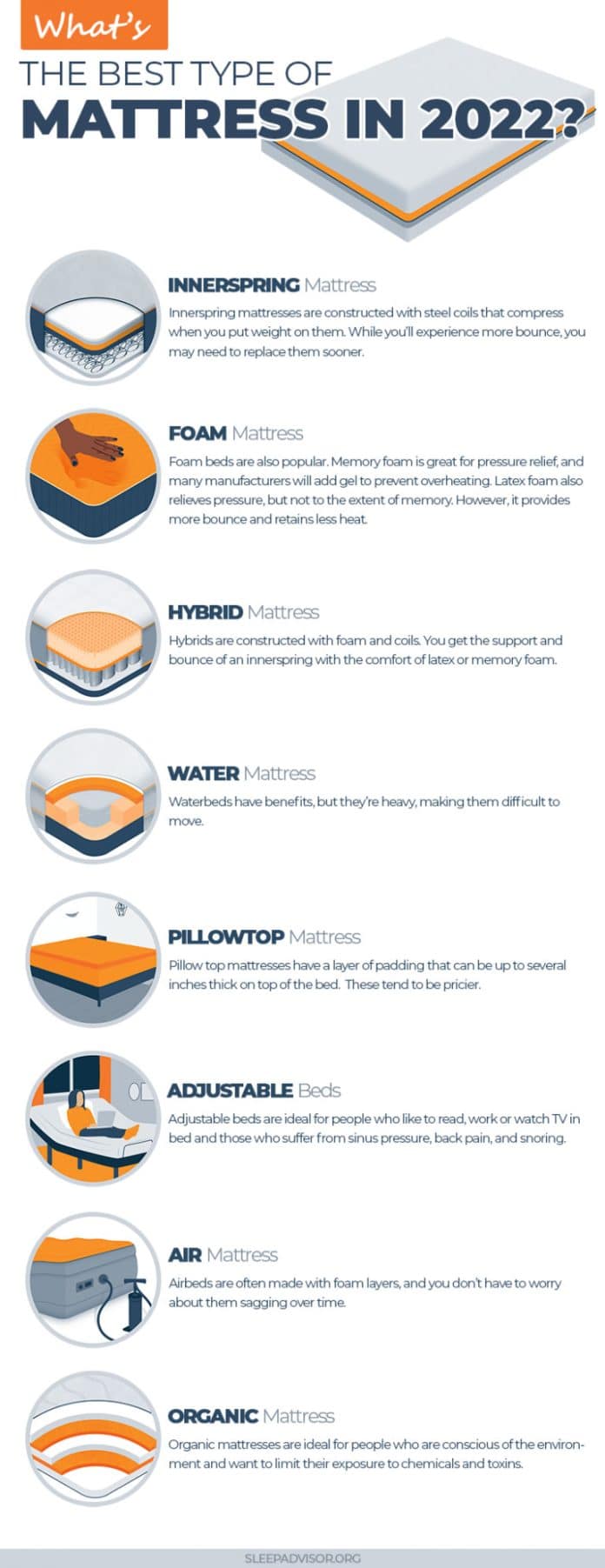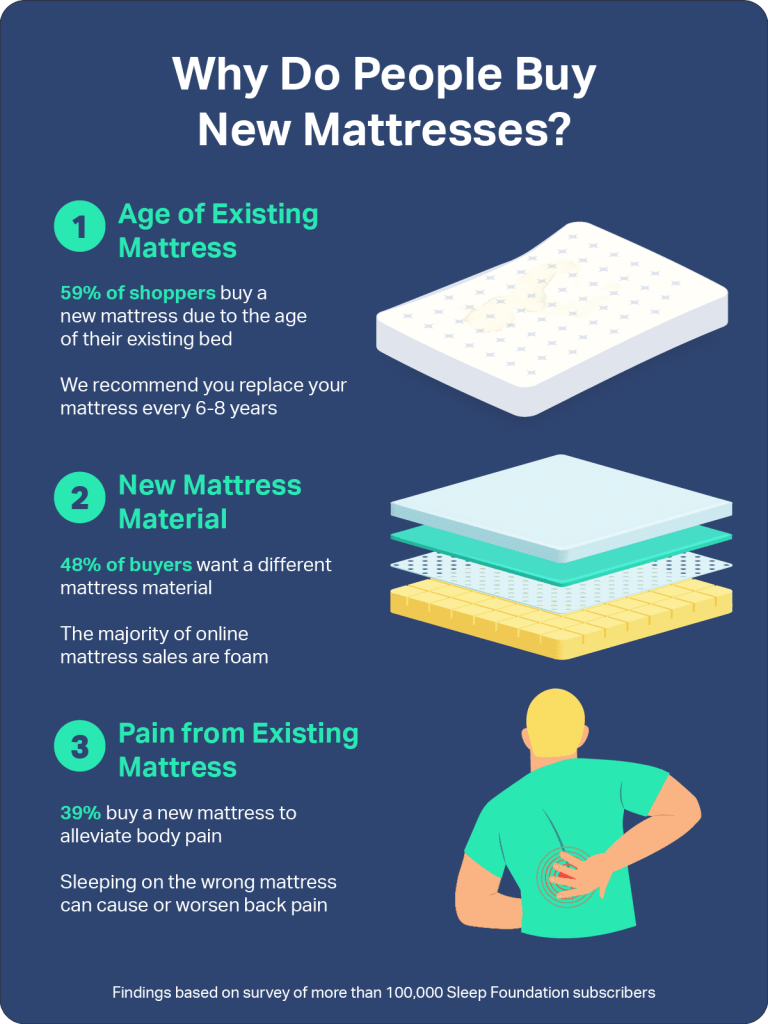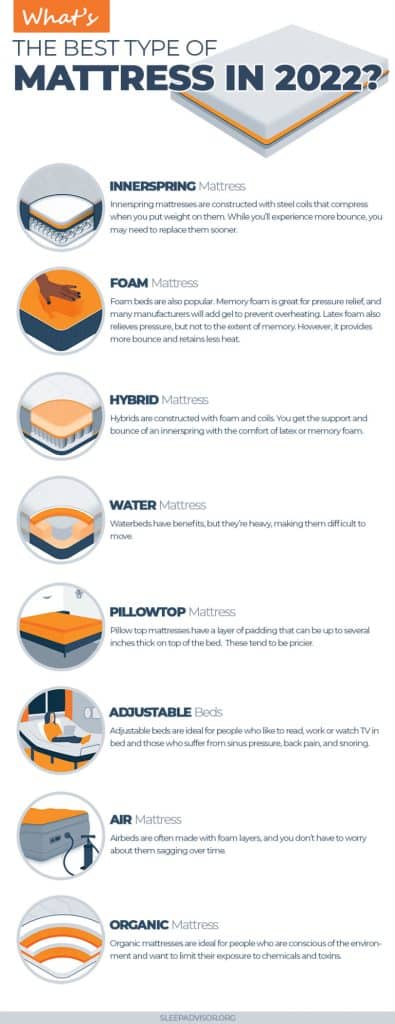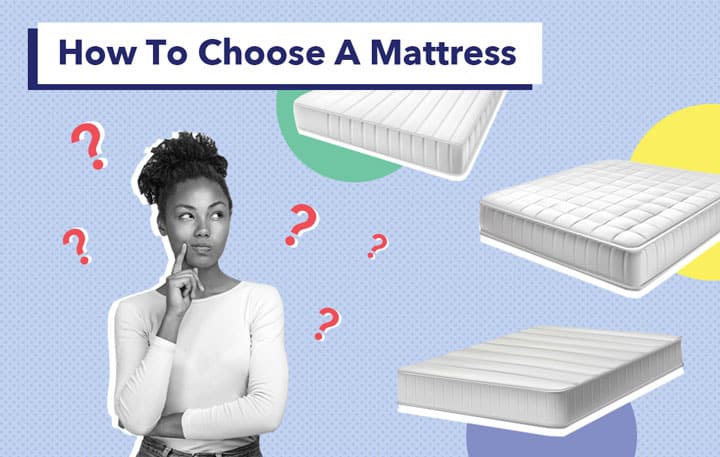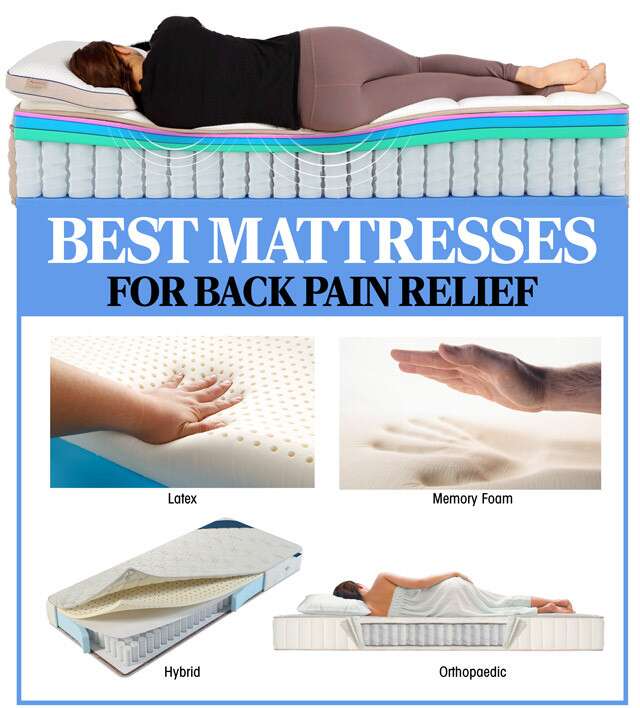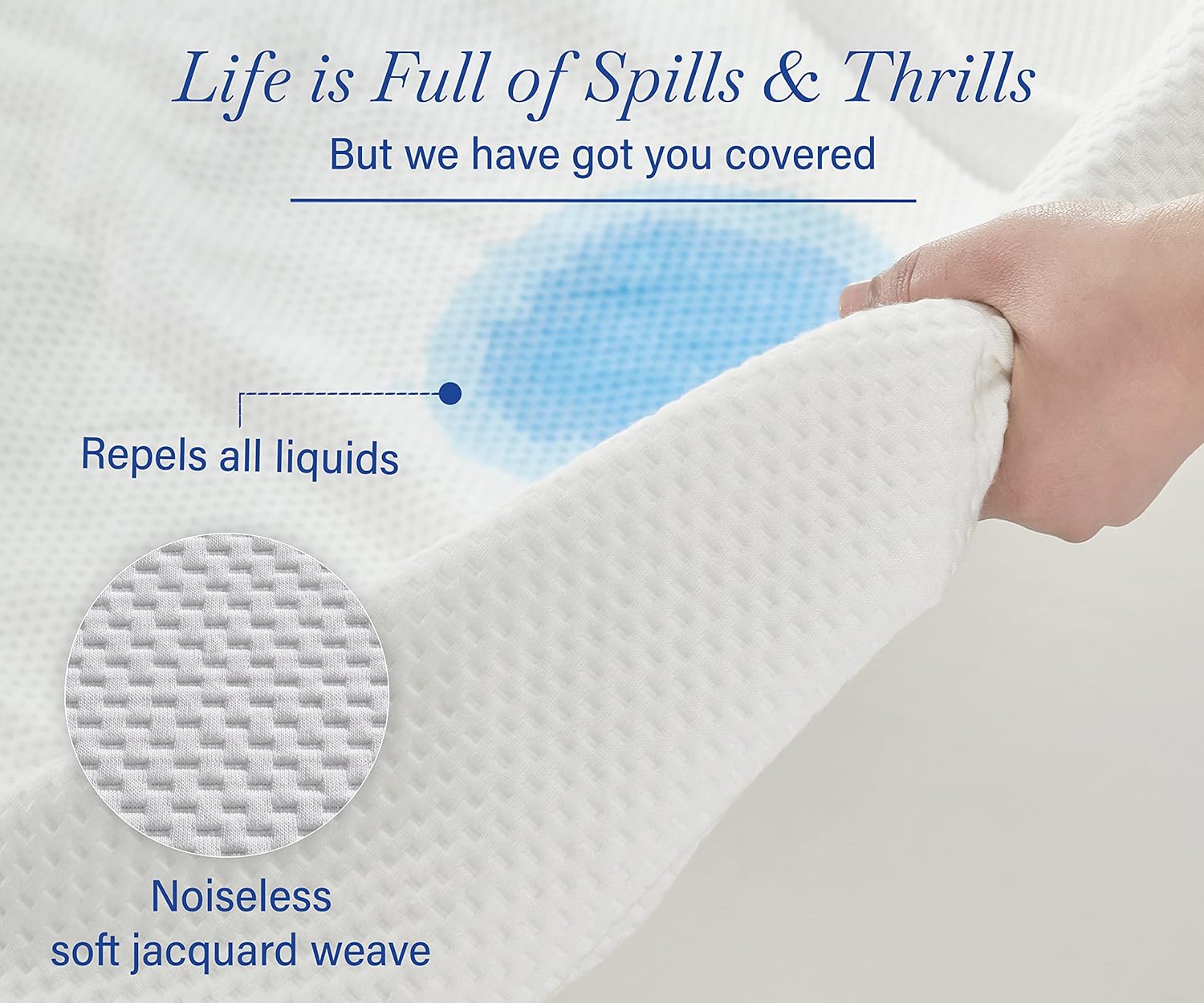Looking for a good night’s sleep? Look no further! In this article, we are going to explore the world of mattresses and uncover the best type for achieving a restful slumber. We’ll be diving into the realm of memory foam, latex, innerspring, and hybrid mattresses, discussing their unique properties and how they can improve the quality of your sleep. So, whether you’re a side sleeper, stomach sleeper, or someone who tosses and turns throughout the night, join us as we uncover the secret to finding the perfect mattress for a rejuvenating sleep experience.
Review contents
Understanding the Importance of a Good Mattress
A good night’s sleep is essential for our overall health and well-being. One factor that plays a significant role in ensuring quality sleep is having a good mattress. A mattress that is comfortable and supportive can greatly improve our sleep quality, while a bad mattress can have negative impacts on our sleep and overall health. Let’s explore the importance of a good mattress and how it can affect our sleep.
Impacts of a Bad Mattress on Sleep Quality
Sleeping on a bad mattress can have various negative effects on our sleep quality. A mattress that is old, worn out, or uncomfortable can lead to disrupted sleep patterns and restless nights. Some common impacts of a bad mattress on sleep quality include:
-
Poor Spinal Alignment: A mattress that lacks proper support and contouring can cause improper spinal alignment. This can lead to discomfort, pain, and stiffness in the back, neck, and joints.
-
Pressure Points: A mattress that is too firm or too soft can create pressure points on certain areas of the body, such as the hips, shoulders, and knees. These pressure points can cause pain and discomfort, leading to frequent tossing and turning during the night.
-
Increased Movement: If you share your bed with a partner, a bad mattress can make you more susceptible to feeling their movements throughout the night. This can disturb your sleep and make it difficult to stay asleep for long periods.
-
Allergies and Respiratory Issues: An old mattress can accumulate dust mites, allergens, and other harmful bacteria over time. Breathing in these particles can trigger allergies, asthma, and other respiratory issues, causing disturbed sleep and discomfort.
Benefits of a Good Mattress for Quality Sleep
On the other hand, investing in a good mattress can provide numerous benefits for quality sleep. A mattress that is designed to provide proper support, comfort, and pressure relief can greatly enhance our sleep experience. Some key benefits of a good mattress include:
-
Improved Sleep Posture: A good mattress is designed to align the spine properly, ensuring a healthy sleep posture. It provides support to the natural curves of the body, reducing the risk of pain and discomfort.
-
Pressure Relief: A quality mattress distributes the body weight evenly, relieving pressure points and reducing the risk of pain and discomfort. This helps prevent the need to constantly change positions during the night.
-
Motion Isolation: A good mattress is designed to minimize motion transfer, meaning that any movement on one side of the bed is not felt on the other side. This is especially beneficial for couples, as it allows for undisturbed sleep even if one person moves during the night.
-
Allergen-Free and Hypoallergenic Materials: Many modern mattresses are made with hypoallergenic materials that resist dust mites, allergens, and bacteria. This promotes a healthier sleeping environment, free from allergens that can cause allergies and respiratory issues.
This image is property of www.sleepfoundation.org.
Factors to Consider when Choosing a Mattress
Choosing the right mattress involves considering several factors that can greatly influence your sleep quality. Everyone has unique needs and preferences when it comes to mattresses, so it’s essential to evaluate these factors before making a decision. Here are some key factors to consider when choosing a mattress:
Sleeping Position
Your sleeping position plays a significant role in determining the type of mattress that will provide optimal support and comfort. Different sleeping positions require different levels of firmness and support. Here are some common sleeping positions and the type of mattress that works best for each:
-
Side Sleepers: Side sleepers typically benefit from a mattress that is slightly softer. This helps cushion the shoulders and hips, aligning the spine properly and relieving pressure points.
-
Back Sleepers: Back sleepers generally require a mattress with medium firmness to maintain proper spine alignment. This helps prevent back pain and discomfort.
-
Stomach Sleepers: Stomach sleepers typically need a firmer mattress to keep their spine properly aligned. This helps prevent the lower back from sinking too much, reducing the risk of pain and discomfort.
Mattress Firmness
Mattress firmness refers to how soft or firm a mattress feels when you lie on it. Different individuals have different preferences when it comes to firmness, so it’s crucial to find the right balance for your comfort needs. Mattresses are typically categorized into the following firmness levels:
-
Soft: Soft mattresses offer a plush and cushioned feel. They contour to the body’s curves and provide excellent pressure relief. Soft mattresses are suitable for individuals who prefer a more “sink-in” feeling and who sleep predominantly on their sides.
-
Medium: Medium-firm mattresses strike a balance between softness and firmness. They provide a comfortable level of support and are suitable for a wide range of sleep positions. Medium-firm mattresses are a popular choice for couples with different sleep preferences.
-
Firm: Firm mattresses offer a sturdy and supportive surface with minimal sinkage. They are ideal for individuals who require extra support, such as back sleepers and stomach sleepers. Firm mattresses help maintain proper spinal alignment and prevent excessive sinking.
Body Weight and Type
Your body weight and type also influence the type of mattress that will provide optimal support and comfort. Different mattresses are designed with varying levels of support to accommodate different body types. Here’s how body weight and type come into play when choosing a mattress:
-
Lightweight Individuals: Lightweight individuals may benefit from softer mattresses as they provide better contouring and pressure relief. Softer mattresses help prevent discomfort and ensures proper spinal alignment.
-
Average Weight Individuals: Average weight individuals have a wider range of options when it comes to choosing a mattress. Medium-firm mattresses tend to work well for most people, as they offer a good balance between support and comfort.
-
Heavyweight Individuals: Heavyweight individuals typically require a firmer mattress to provide adequate support and prevent excessive sinking. Firmer mattresses help distribute the body weight evenly, reducing the risk of discomfort and pain.
Temperature Regulation
Temperature regulation is an essential factor to consider, especially if you tend to sleep hot or cold. Some mattresses are designed with materials that help regulate body temperature and promote airflow, keeping you cool and comfortable throughout the night. Here are some features to look for in a mattress that prioritizes temperature regulation:
-
Gel Infusions: Mattresses with gel-infused memory foam or latex layers help dissipate heat more efficiently, preventing the buildup of excess body heat.
-
Breathable Materials: Look for mattresses made with breathable materials like natural fibers or perforated foam. These materials promote airflow and allow heat to escape, ensuring a cool and comfortable sleep surface.
Motion Isolation
If you share your bed with a partner, motion isolation becomes an important consideration. A mattress with good motion isolation capabilities minimizes the transfer of motion from one side of the bed to the other. This is particularly beneficial if your partner tends to move around or get in and out of bed frequently. Mattresses with memory foam or pocketed coil systems generally excel in motion isolation, allowing both you and your partner to enjoy uninterrupted sleep.
This image is property of www.sleepadvisor.org.
Different Types of Mattresses
Now that we have discussed the factors to consider when choosing a mattress, let’s explore the different types of mattresses available in the market. Each type offers unique features and benefits, catering to different sleep preferences and needs. Here are some of the most common types of mattresses:
Innerspring Mattresses
Innerspring mattresses are one of the most traditional types of mattresses available. They are constructed with a support core of metal coils and are topped with comfort materials such as foam or fiberfill. Innerspring mattresses offer a bouncy and responsive feel, making them suitable for individuals who prefer a traditional mattress experience.
Construction and Support
Innerspring mattresses feature a support core made up of individual metal coils or springs. The number and thickness of the coils can vary, affecting the overall support and durability of the mattress. On top of the coil system, innerspring mattresses typically have comfort layers of foam, fiberfill, or a combination of both. These comfort layers provide cushioning and contouring, enhancing comfort.
Pros and Cons
Pros:
- Good breathability and temperature regulation due to the open structure of the coils.
- Bouncy and responsive feel, ideal for those who prefer a traditional mattress experience.
- Wide range of firmness options available to suit various sleep preferences.
- Generally more affordable compared to other mattress types.
Cons:
- Limited motion isolation, as the coils can transfer motion across the mattress.
- Less contouring and pressure relief compared to foam or latex mattresses.
- Potential for noise due to the metal coils.
Who It’s Best for
Innerspring mattresses are best suited for individuals who prefer a traditional mattress feel with a springy bounce. They are also a suitable choice for sleepers who tend to sleep hot, as the coils allow for good airflow. Additionally, innerspring mattresses can be a budget-friendly option for those seeking a comfortable and supportive sleep surface.
Memory Foam Mattresses
Memory foam mattresses have gained popularity over the years for their ability to contour to the body’s shape and provide pressure relief. They are constructed with layers of memory foam, which is a viscoelastic material that responds to heat and pressure. Memory foam mattresses offer excellent motion isolation and conformability, making them a popular choice for many sleepers.
Construction and Support
Memory foam mattresses consist of multiple layers, typically including a base layer for support and one or more comfort layers made of memory foam. The base layer provides overall stability and support, while the comfort layers offer contouring and pressure relief. Memory foam mattresses may also feature additional technologies such as gel-infused foam or open-cell foam to enhance breathability and temperature regulation.
Pros and Cons
Pros:
- Exceptional contouring and pressure relief, relieving pain and promoting proper spinal alignment.
- Excellent motion isolation, making them ideal for couples or individuals who share a bed.
- Wide range of firmness options available, catering to different sleep preferences.
- Can provide relief for those with chronic pain conditions such as arthritis or fibromyalgia.
Cons:
- Potential for heat retention, although newer memory foam mattresses often incorporate cooling technologies.
- Minimal bounce and responsiveness, which some sleepers may not prefer.
- May have a slight off-gassing odor initially, although it dissipates over time.
Who It’s Best for
Memory foam mattresses are an excellent choice for sleepers who prioritize pressure relief and contouring. They are particularly beneficial for individuals with chronic pain conditions or those who want to minimize motion transfer. Memory foam mattresses have a slow response time, allowing them to mold to the body’s shape and distribute weight evenly.
Latex Mattresses
Latex mattresses are known for their natural and eco-friendly materials. They are made from either natural latex, which is derived from rubber trees, or synthetic latex, which is a man-made material. Latex mattresses offer a unique combination of comfort, support, and durability, making them a popular choice among sleepers.
Construction and Support
Latex mattresses can be constructed using either the Dunlop or Talalay process. The Dunlop process produces denser and firmer latex, while the Talalay process creates a softer and more buoyant feel. Latex mattresses usually consist of multiple layers of latex foam, with varying densities to provide targeted support and comfort. They may also contain additional layers such as a base layer or a plush pillow top for added cushioning.
Pros and Cons
Pros:
- Excellent durability and longevity, with latex mattresses often outlasting other mattress types.
- Natural latex mattresses are hypoallergenic and resistant to dust mites, mold, and mildew.
- Good breathability and temperature regulation due to the open-cell structure of latex foam.
- Exceptional responsiveness and bounce, allowing for ease of movement.
Cons:
- Relatively higher price point compared to other mattress types.
- May have a slight initial odor, although it dissipates quickly.
- Limited availability of natural latex mattresses compared to synthetic latex.
Who It’s Best for
Latex mattresses are ideal for sleepers who prefer a responsive and resilient sleep surface. They are especially beneficial for individuals with allergies or those who prefer eco-friendly and natural materials. Latex mattresses excel in durability and often come with long warranties, making them a worthwhile investment for those seeking long-term comfort and support.
Hybrid Mattresses
Hybrid mattresses combine the best features of different mattress types, typically combining an innerspring system with layers of foam or latex. This blend of materials offers the support and bounce of an innerspring mattress, along with the contouring and pressure relief of foam or latex. Hybrid mattresses provide a balance between the traditional feel of innerspring mattresses and the comfort of foam or latex.
Construction and Support
Hybrid mattresses typically have a base layer of pocketed coils for support, combined with multiple layers of foam or latex for comfort and contouring. The coil system provides stability and durability, while the comfort layers offer cushioning and pressure relief. The top layer of a hybrid mattress can be made of memory foam, latex, or a combination of materials, depending on the specific design.
Pros and Cons
Pros:
- Offers a balance between the support and bounce of an innerspring mattress and the comfort and contouring of foam or latex.
- Good breathability and temperature regulation due to the coil system and combination of materials.
- Wide range of firmness options available to suit different sleep preferences.
- Provides excellent motion isolation, minimizing the disturbance caused by a partner’s movements.
Cons:
- Higher price range compared to traditional innerspring mattresses.
- May be heavier than other mattress types due to the combination of materials.
- The different layer combinations can vary greatly, so it’s essential to find a hybrid mattress that suits your specific comfort needs.
Who It’s Best for
Hybrid mattresses are a versatile choice suitable for a wide range of sleepers. They provide the benefits of both innerspring mattresses and foam or latex mattresses, making them suitable for those who want a balanced sleep experience. Hybrid mattresses work well for individuals who enjoy a combination of support, bounce, contouring, and pressure relief.
Airbeds
Airbeds are unique mattresses that allow users to adjust the firmness level by inflating or deflating air chambers within the mattress. These mattresses often come with remote controls or smartphone apps for easy customization. Airbeds provide excellent adjustability and personalized comfort, making them popular among sleepers with specific firmness preferences.
Construction and Support
Airbeds are constructed with air chambers that can be adjusted to different levels of firmness. These chambers are usually made of durable materials such as rubber or polyurethane, designed to withstand the air pressure. Airbeds also feature comfort layers made of foam or latex, providing cushioning and support on top of the air chambers.
Pros and Cons
Pros:
- Adjustable firmness levels, allowing individuals to customize their sleep experience.
- Ideal for couples with different firmness preferences, as each side of the bed can be adjusted independently.
- Excellent contouring and pressure relief, as the mattress can be precisely adjusted to the desired level of support.
- Long-lasting and durable, with the ability to replace or repair individual components if needed.
Cons:
- Some airbeds may have noise issues due to the air pumps or materials used.
- Air leaks can occur, requiring occasional maintenance to ensure consistent firmness.
- Higher price range compared to traditional mattress types.
Who It’s Best for
Airbeds are best suited for sleepers who want complete control over their mattress firmness. They are particularly beneficial for individuals with specific health conditions or those who require varying levels of support. Airbeds also work well for couples with different firmness preferences, as each side of the bed can be adjusted independently to meet individual needs.
Waterbeds
Waterbeds are a unique type of mattress that uses water as the primary support system. They are known for their distinct feel and ability to contour to the body’s shape. Waterbeds offer a gentle and floating sensation, providing pressure relief and minimizing the impact on joints. However, waterbeds have become less common in recent years due to their specific care requirements and limited availability.
Construction and Support
Waterbeds consist of a vinyl bladder filled with water, which acts as the support system. The water can be heated or cooled to desired temperatures for added comfort. Waterbeds may also have additional layers of foam or fiberfill for cushioning and insulation. The water in the bladder allows the mattress to conform to the body’s shape, giving a unique floating sensation.
Pros and Cons
Pros:
- Excellent pressure relief and contouring, as the water conforms to the body’s shape.
- Customizable temperature settings for personalized comfort and relaxation.
- Minimal motion transfer, allowing undisturbed sleep for couples or individuals sharing the bed.
- Longevity and durability, with proper maintenance and care.
Cons:
- Requires specific care and maintenance, such as periodically conditioning the vinyl and monitoring water levels.
- Relatively high weight, making it challenging to move or rotate the mattress.
- Limited availability and specialized bedding requirements.
Who It’s Best for
Waterbeds are suitable for individuals seeking a unique sleep experience and those who enjoy the gentle and floating sensation of sleeping on water. They can be particularly beneficial for sleepers with joint or muscle pain, as waterbeds offer excellent pressure relief and minimize the impact on the body. However, it’s important to note that waterbeds require specific care and maintenance, and they may not be readily available in all locations.
This image is property of sleepopolis.com.
Conclusion
Choosing the right mattress is crucial for ensuring quality sleep and overall well-being. A good mattress provides the necessary support, comfort, and pressure relief that our bodies need to relax and rejuvenate during sleep. Factors such as sleeping position, mattress firmness, body weight and type, temperature regulation, and motion isolation should be considered when selecting a mattress. By understanding the various types of mattresses available, including innerspring, memory foam, latex, hybrid, airbeds, and waterbeds, individuals can make an informed decision based on their sleep preferences and needs. With the right mattress, everyone can enjoy a restful and revitalizing sleep, promoting optimal health and happiness.
This image is property of femina.wwmindia.com.

